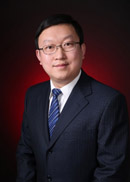报告题目1:Limits on the impermeability of graphene
报告人:孙鹏展 博士(澳门大学应用物理及材料工程研究院)
报告题目2:新型光电/辐射探测材料与器件及其应用探索
报告人:沈亮 教授(吉林大学)
时间:5月10日(周五)14:00
地点:师昌绪楼403会议室
Limits on the impermeability of graphene
报告人简介

孙鹏展博士现为澳门大学应用物理及材料工程研究院(Institute of Applied Physics and Materials Engineering ,IAPME)助理教授。2023港澳优青获得者。曾于2012年和2016年在清华大学获得工学学士和博士学位。2016年至2022年,在英国曼彻斯特大学物理与天文系和国家石墨烯研究院从事博士后研究工作,合作导师为Andre Geim教授。其研究兴趣包括对强限域条件下的分子输运行为的基础性探索,制备及定制化组装二维晶体为具有特定功能的异质结构器件,并探究其在分子筛分、蓝色能源收集以及仿生信号传递与信息交互等领域的新技术与新应用。迄今为止,以第一及通讯作者身份在Nature,PNAS,Nature Communications,Science Advances等期刊发表研究论文20余篇。相关研究成果已获日本专利1项及中国专利2项。此外,孙鹏展曾荣获美国材料研究学会(MRS)研究生银奖、清华大学特等奖学金、中国国际石墨烯创新创业大赛一等奖以及清华–陶氏可持续发展创新挑战赛特等奖等奖项。
报告摘要:It is widely believed that,despite being one-atom thick,graphene is completely impermeable to all gases and liquids. In this talk,I will present my recent research1-4 on the topic “How permeable is the impermeable graphene?”
Using monocrystalline container made from atomically flat graphite,which is tightly sealed with graphene,we have achieved measurements that put the permeation limit through 2D materials at 8–9 orders of magnitude lower than previously,such that we would discern (but did not observe) just a few helium atoms per hour crossing micrometer-size membranes. This detection limit is also valid for all other gases tested,except for hydrogen. Hydrogen shows noticeable permeation,even though its molecule is larger than helium. The mechanism of this anomalous observation is proposed and later corroborated by experiments. To make the generally “impermeable” graphene not only “permeable” but also highly “selective”,we have developed a perforation technique which involves a short-time exposure of the graphene membrane to low-energy electrons. Using the same monocrystalline containers,we are able to study gas transport through the created individual graphene pores with an effective size of about one missing carbon ring. Helium and hydrogen permeate easily through these pores whereas larger molecules such as xenon and methane are blocked. Permeating gases experience activation barriers that increase quadratically with the kinetic diameter,and the transport process crucially involves surface adsorption.
1.P. Z. Sun,et al. Nature 579,229 (2020).
2.P. Z. Sun,et al. Nat. Commun. 12,7170 (2021).
3.P. Z. Sun,et al. PNAS 120,e2300481120 (2023).
4.Z. F. Wu,P. Z. Sun*,et al. Nat. Commun. 14,7756 (2023).
新型光电/辐射探测材料与器件及其应用探索
报告人简介
沈亮,吉林大学教授,博士生导师,国家青年人才计划入选者,吉林大学电子科学与工程学院副院长。依托集成光电子学国家 重点实验室和微纳信息材料与器件(111引智基地),主要从事新型半导体光电转换材料、器件与系统的研究工作,以新材料机理探索-高性能器件研发-新应用系统集成为研究主线,在高速光电子理论及器件、低偏压高灵敏X射线探测和超高稳定光电倍增管等方面取得重要原创成果,在光通信、光互联和光信息处理方面取得重要应用,服务国家重大战略。在Nat.Photon.,Nat.Water,Nat.Commun.,Sci.Adv.,Adv. Mater.,Nano Lett.,Adv. Funct. Mater.,Adv. Energy Mater.,Light-Sci. Appl.等国际重要学术期刊发表SCI检索论文>200篇,引用>10000次(google学术),H因子55,授权美国及中国发明专利>30项。获得2015年吉林省科学技术奖自然科学一等奖。目前任《半导体学报》、《InfoMat》、《SmartMat》、《InfoScience》、《光子学报》、《激光与光电子学进展》期刊青年编委。
重点实验室和微纳信息材料与器件(111引智基地),主要从事新型半导体光电转换材料、器件与系统的研究工作,以新材料机理探索-高性能器件研发-新应用系统集成为研究主线,在高速光电子理论及器件、低偏压高灵敏X射线探测和超高稳定光电倍增管等方面取得重要原创成果,在光通信、光互联和光信息处理方面取得重要应用,服务国家重大战略。在Nat.Photon.,Nat.Water,Nat.Commun.,Sci.Adv.,Adv. Mater.,Nano Lett.,Adv. Funct. Mater.,Adv. Energy Mater.,Light-Sci. Appl.等国际重要学术期刊发表SCI检索论文>200篇,引用>10000次(google学术),H因子55,授权美国及中国发明专利>30项。获得2015年吉林省科学技术奖自然科学一等奖。目前任《半导体学报》、《InfoMat》、《SmartMat》、《InfoScience》、《光子学报》、《激光与光电子学进展》期刊青年编委。
报告摘要:探测器是航空、航天和信息等领域的核心器件。基于传统半导体材料的光电探测器重量大,刚性易碎,难以实现轻量化,而以有机、钙钛矿和量子点材料为代表的新型光电探测器具有工艺简单,成本低、重量轻等优点,有希望满足国家战略需求。报告人长期从事新型半导体探测器的研究,合成具有高质量高稳定性的钙钛矿单晶,研制出高灵敏、低驱动电压、便携式钙钛矿X射线探测器;通过表面功能化设计和减少器件电容的协同策略,实现纳秒量级的响应速度;以吸收光谱互补为原则选择材料,根据载流子界面输运原则设计器件结构,研制出集宽谱段、快响应、大动态线性范围于一体的新型光电探测器,实现近红外高速扫描成像。已经报道的各类高灵敏、多谱段、快响应、大动态线性范围的探测器,应用于光通信和成像,实现了不同谱段光信号的精准传输和高精度成像,展示其在航空航天和光电信息领域的应用潜力,为新型探测器走向实用化做出了有意义的探索。



